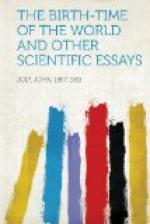[1] See the essay on Denudation.
18
the rivers draining to the ocean will be influenced not only by present denudative effects, but also by the stored results of past effects. Certain rivers appear to reveal this unduly increased salt supply those which flow through comparatively arid areas. However, the flowoff of such tributaries is relatively small and the final effects on the great rivers apparently unimportant—a result which might have been anticipated when the extremely slow rate of the land movements is taken into account.
The difficulty of effecting any reconciliation of the methods already described and that now to be given increases the interest both of the former and the latter.
THE AGE BY RADIOACTIVE TRANSFORMATIONS
Rutherford suggested in 1905 that as helium was continually being evolved at a uniform rate by radioactive substances (in the form of the alpha rays) a determination of the age of minerals containing the radioactive elements might be made by measurements of the amount of the stored helium and of the radioactive elements giving rise to it, The parent radioactive substances are—according to present knowledge—uranium and thorium. An estimate of the amounts of these elements present enables the rate of production of the helium to be calculated. Rutherford shortly afterwards found by this method an age of 240 millions of years for a radioactive mineral of presumably remote age. Strutt, who carried
19
his measurements to a wonderful degree of refinement, found the following ages for mineral substances originating in different geological ages:
Oligocene — 8.4 millions of years.
Eocene — 31 millions of years.
Lower Carboniferous — 150 millions of years.
Archaean — 750 millions of
years.
Periods of time much less than, and very inconsistent with, these were also found. The lower results are, however, easily explained if we assume that the helium—which is a gas under prevailing conditions—escapes in many cases slowly from the mineral.
Another product of radioactive origin is lead. The suggestion that this substance might be made available to determine the age of the Earth also originated with Rutherford. We are at least assured that this element cannot escape by gaseous diffusion from the minerals. Boltwood’s results on the amount of lead contained in minerals of various ages, taken in conjunction with the amount of uranium or parent substance present, afforded ages rising to 1,640 millions of years for archaean and 1,200 millions for Algonkian time. Becker, applying the same method, obtained results rising to quite incredible periods: from 1,671 to 11,470 millions of years. Becker maintained that original lead rendered the determinations indefinite. The more recent results of Mr. A. Holmes support the conclusion that “original” lead may be present and may completely falsify results derived




